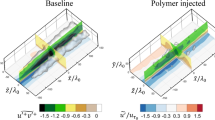Abstract
Direct numerical simulation (DNS) of forcing homogeneous isotropic turbulence with polymers was performed. In order to understand the polymers effect on turbulent coherent structures, proper orthogonal decomposition was performed to identify coherent structures based on DNS data, so as to analyze the remarkable difference due to the addition of polymers. The results showed that the numbers for eigenmodes required for capturing coherent structures were 32 and 24 for the Newtonian fluid and polymer solution flows, respectively, which means the decrease of the complexity in polymer solution flow. Through the POD energy spectrum, it was found that the turbulent kinetic energy is distributed onto a large number of eigenmodes whether in the Newtonian fluid flow or polymer solution flow, suggesting that polymer solution flow is still turbulent in one aspect. Besides, the POD eigenmodes were investigated, which found that the small-scale structures are inhibited in polymer solution flow.
Similar content being viewed by others
References
Toms B A. Some observation on the flow of linear polymer solutions through straight tubes at large Reynolds number. In: Proceedings of the first International Congress of Rheology, North Holland, 1949. 135–148
Lumley J L. Drag reduction in turbulent flow by polymer additives. J Polymer Sci Macrom Rew, 1973, 7: 263–290
Ptasinski P K, Boersma B J, Nieuwstadt F T M, et al. Turbulent channel flow near maximum drag reduction: simulations, experiments and mechanisms. J Fluid Mech, 2003, 490: 251–291
Walker D T, Tiederman W G. Turbulent structure in a channel flow with polymer injection at the wall. J Fluid Mech, 1990, 218: 377–403
Den Toonder J M J, Hulsen M A, Kuiken G D C, et al. Drag reduction by polymer additives in a turbulent pipe flow: Numerical and laboratory experiments. J Fluid Mech, 1997, 337: 193–231
Li F C, Kawaguchi Y, Segawa T, et al. Reynolds-number dependence of turbulence structures in a drag-reducing surfactant solution channel flow investigated by PIV. Phys Fluids, 2005, 17: 075104
Sureshkumar R, Beris A N, Handler A H. Direct numerical simulation of turbulent channel flow of a polymer solution. Phys Fluids, 1997, 9: 743–755
Yu B, Kawaguchi Y. Direct numerical simulation of viscoelastic drag-reducing flow: A faithful finite difference method. J Non-Newtonian Fluid Mech, 2004, 116: 431–466
van Doorn E, White C M, Sreenivasan K R. The decay of grid turbulence in polymer and surfactant solutions. Phys Fluids, 1999, 8: 2387–2393
De Angelis E, Casciola C M, Benzi R, et al. Homogeneous isotropic turbulence in dilute polymers. J Fluid Mech, 2005, 531: 1–10
Berti S, Bistagnino A, Boffetta G, et al. Small-scale statistics of viscoelastic turbulence. Europhys Letts, 2006, 76: 63–69
Perlekar P, Mitra D, Pandit R. Manifestations of drag reduction by polymer additives in decaying, homogenous, isotropic turbulence. Phys Rev Lett, 2006, 97: 264501
Cai W H, Li F C, Zhang H N. DNS study of decaying homogeneous isotropic turbulence with polymer additives. J Fluid Mech, 2010, 665: 334–356
Liberzon A, Guala M, Luthi B, et al. Turbulence in dilute polymer solutions. Phys Fluids, 2005, 17: 031707
Ouellette N T, Xu H T, Bodenschatz E. Bulk turbulence in dilute polymer solutions. J Fluid Mech, 2009, 629: 375–385
Kim K, Li C F, Sureshkumar R, et al. Effects of polymer stresses on eddy structures in drag-reduced turbulent channel flow. J Fluid Mech, 2007, 584: 281–299
Kim K, Adrian R J, Balachandar S, et al. Dynamics of hairpin vortices and polymer-induced turbulent drag reduction. Phys Rev Letts, 2008, 100: 134504
Sibilla S, Beretta C P. Near-wall coherent structures in the turbulent channel flow of a dilute polymer solution. Fluid Dyn Res, 2005, 37: 183–202
Yu Z S, Lin J Z, Fan X J. Numerical simulation of interactions between rigid rod-like polymers and coherent structures in a mixing layer. J Non-Newtonian Fluid Mech, 1999, 83: 1–18
Shao X M, Lin J Z, Yu Z S. Research on coherent structures in a mixing layer of the FENE-P polymer solution. Appl Math Mech, 2001, 22(3): 304–311
Vaithianathan T, Robert A, Brasseur J G, et al. An improved algorithm for simulating three-dimensional, viscoelastic turbulence. J Non-Newtonian Fluid Mech, 2006, 140: 3–22
Canuto C, Hussaini M Y, Quarteroni A, et al. Spectral Methods in Fluid Dynamics. New York: Spring-Verlag, 1988
Chen S, Doolen G D, Kraichnan R H. On statistical correlations between velocity increments and locally averaged dissipation in homogeneous turbulence. Phys Fluids, 1993, 5: 458–463
Li F C, Cai W H, Zhang H N. Influence of polymer additives on turbulent energy cascading in forced homogeneous isotropic turbulence studied by DNS. J Non-Newtonian Fluid Mech, 2011, in Submitted
Samanta G, Oxberry G M, Beris A N, et al. Time-evolution K-L analysis of coherent structures based on DNS of turbulent Newtonian and viscoelastic flows. J Turbul, 2008, 41: 1–25
Samanta G, Beris A N, Handler R A, et al. Velocity and conformation statistics based on reduced Karhunen-Loeve projection data from DNS of viscoelastic turbulent channel flow. J Non-Newtonian Fluid Mech, 2009, 160: 55–63
Cai W H, Li F C, Zhang H N, et al. Study on the characteristics of turbulent drag-reducing channel flow by particle image velocimetry combining with proper orthogonal decomposition analysis. Phys Fluids, 2009, 21: 115103
Lumley J L. The structure of inhomogeneous turbulent flows. Atmospheric Turbulence and Radio Wave Propagation. Yaglom A M, Tararsky V I, eds. Moscow: Nauka, 1967
Author information
Authors and Affiliations
Corresponding authors
Rights and permissions
About this article
Cite this article
Cai, W., Li, F., Zhang, H. et al. Analysis of coherent structures in drag-reducing polymer solution flow based on proper orthogonal decomposition. Sci. China Phys. Mech. Astron. 55, 854–860 (2012). https://doi.org/10.1007/s11433-012-4672-2
Received:
Accepted:
Published:
Issue Date:
DOI: https://doi.org/10.1007/s11433-012-4672-2




